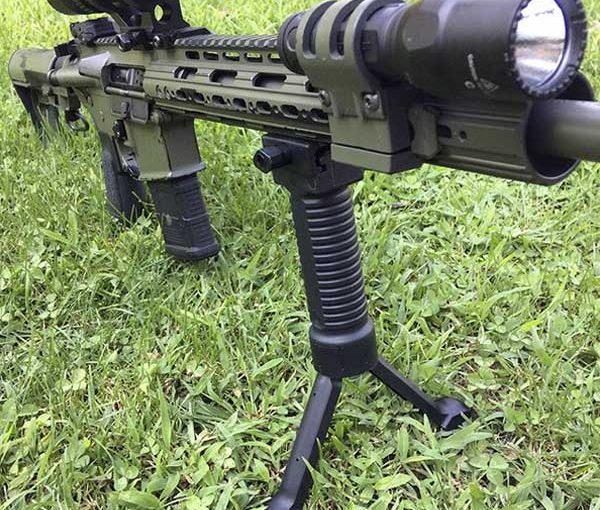AR-15 Bipod Foregrip, GRIP POD
Picatinny rails are a blessing and curse on a rifle. You can put whatever you want where you want on your gun, but with railing space at a premium and weapon weight, the ever-present concern deciding just what you want and what you could live without becomes hard. There is a product in the industry right now, which is meant to do that choice a bit simpler by mixing Two functions in one solution for mounting on a rail: Grip Pod. In competition shooting, a vertical foregrip and a bipod are functions on a gun. The forward perpendicular grip provides the shooter an indicator point to grab the gun and add a few ergonomically positioned surface area against which they may push when swinging the gun out of one side to the other.
Additionally, I find it much more comfortable to rest my hands as opposed to directly swaying the handguard. The advantage of a bipod for long range shots from several positions is self-evident as the more secure the shooting position you’ve, the most accurate of your fire is going to be, and a bipod is pretty damn secure. However, having both of those features on a gun at the same time takes up large amounts of railroad space, and on mid-span handguards sets the vertical grip too close to the magazine well to be genuinely helpful. Input the Grip Pod.
This sole unit not only acts as a vertical foregrip that is chunky But has a stored arc bipod stored within the body prepared to be deployed at the push of a button. At first blush, it seems to be the solution to our problem, but a bit deeper things get unsatisfactory. The vertical foregrip component of the Grip Pod does function indeed as a foregrip, but I’ve got a few complaints. In addition to that, the clasp itself can be a hair too big, the greatest thing that irks me each time I use it’s the twist on the face of the unit.
To make the item simple to attach and remove, they have designed a finger-friendly knob which allows you set the item on and take off it at will – and quite quickly. The matter is that this screw becomes quite annoying for all those of us with big fingers and that I cannot even fathom how our southpaw brethren handle one of those things without being VERY embarrassing. The bipod is the real selling point, but even that falls short of the mark. To retain the weight, the thighs of the bipod are made of plastic that makes them very susceptible to bending and breaking. The gun tends to move backward and forward some as it fires, which stresses the plastic and will ultimately break the legs.
And forget to try to load, the bipod, because that is a sure fire way to snap the legs right off. Only the hill only really works well on smaller calibers, and then doesn’t meet the demands of a bipod on a contest grade firearm. In brief, by going with the Grip Pod, you are getting the worst of the two worlds, a bipod which will break eventually along with a grip that’s somewhat uncomfortable. But here is the thing: I run one on my competition rifle for one reason – nothing does the job better and lighter. If I had to find these components separately, I’d be spending far more money and using tons more railing real estate than I now am, let alone adding additional burden to an already vessel anchor esque firearm.
The Grip Pod not only used up less space than a traditional bipod alone, however, the compact design means fewer probability legs are getting hooked on a loose point gear and breaking me time or DQ. It is also considerably lighter than the combination of the two. However, the biggest draw is the button on the rear of the device that deploys the legs whenever you push it, meaning I do not have to go ahead and manually deploy the legs as with a bipod. There is no doubt that simply by going with the Grip Pod I am missing out on a few of the advantages of a bipod, but the simple fact of the matter is that for me and my ability level, it enough for my needs.
It gives me lots of stability without having to sacrifice weight or railroad space and does it rather inexpensively as well. Layered at the top of the item itself is a few rather fanatical support. They substituted the legs on my grip pod when they eventually decided to announce freedom from the device and disappear in the sands of southern Texas and are seemingly standing by to keep substituting them as they break again down the road. Another side advantage of the fold off design is that of matches in which you are running in an office that does not allow bipods, you are still able to leave it attached, just do not hit the magic button which releases the bipod legs and you are ready to go.
It’s a lot easier whenever you do not have to be continuously swapping out parts on your firearms based on what the CRO decides to create the principles that day. If you are searching for a committed bipod, this isn’t it. And if you are searching for a committed vertical foregrip you can do much better. However, if you want something which works well enough in contest settings, doesn’t take up a great deal of space and is fast and simple to deploy, this could be your ticket. There are a few competitors out there with comparable designs, but none execute the concept quite enjoy this one. The Grip Pod is an illustration of an AR-15 accessory where the value of the whole is greater than the sum of its parts.
